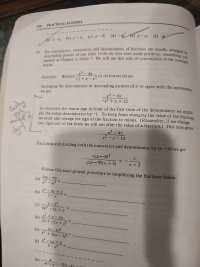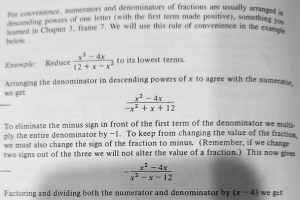Hello, thank you in advance for any help.
I am working my way through Selby&Slavin's Practical Algebra self teaching guide.
In frame 17, 18 and 19 of chapter 5, Fractions, the authors explain their preferred method of reducing fractions by (1) multiplying the denominator by -1 and (2) then adjusting the signs for the numerator.
Can I simply find the same result by multiplying the whole fraction by negative 1? The authors method seems the unusually cumbersome but maybe I am missing something?
TY!!
I am working my way through Selby&Slavin's Practical Algebra self teaching guide.
In frame 17, 18 and 19 of chapter 5, Fractions, the authors explain their preferred method of reducing fractions by (1) multiplying the denominator by -1 and (2) then adjusting the signs for the numerator.
Can I simply find the same result by multiplying the whole fraction by negative 1? The authors method seems the unusually cumbersome but maybe I am missing something?
TY!!


